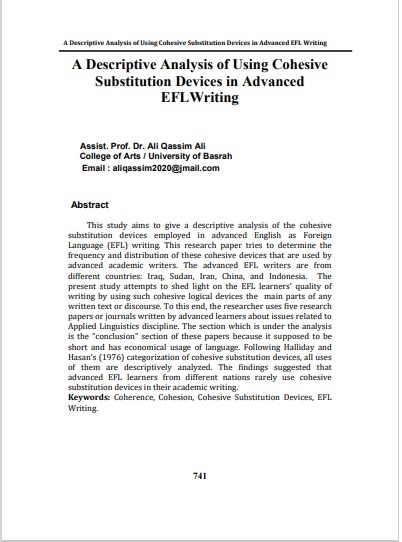A Descriptive Analysis of Using Cohesive Substitution Devices in Advanced EFLWriting
Main Article Content
Abstract
This study aims to give a descriptive analysis of the cohesive substitution devices employed in advanced English as Foreign Language (EFL) writing. This research paper tries to determine the frequency and distribution of these cohesive devices that are used by advanced academic writers. The advanced EFL writers are from different countries: Iraq, Sudan, Iran, China, and Indonesia. The present study attempts to shed light on the EFL learners’ quality of writing by using such cohesive logical devices the main parts of any written text or discourse. To this end, the researcher uses five research papers or journals written by advanced learners about issues related to Applied Linguistics discipline. The section which is under the analysis is the “conclusion” section of these papers because it supposed to be short and has economical usage of language. Following Halliday and Hasan’s (1976) categorization of cohesive substitution devices, all uses of them are descriptively analyzed. The findings suggested that advanced EFL learners from different nations rarely use cohesive substitution devices in their academic writing.
Article Details

This work is licensed under a Creative Commons Attribution-ShareAlike 4.0 International License.
References
-Abdulrahman, Nishad. (2018). Substitution and Ellipsis in the First Year University Students’ English Essay Writing. Journal for Researching Practice and Theory. Vol. 1, No. 2. Pp. 30-40.
-Adiantika, Hanif N. and Astri D. Floranti. (2018). The Use of Substitution And Its Contribution to the Text Cohesion in Students’ Expository Texts. EFT in Focus. Vol. 1. No. 2.
-Brown, G., & Yule, G. (1983). Discourse analysis. Cambridge University Press.
-Celce-Murcia, M. (2007). Rethinking the role of communicative competence in language teaching. In E. Alcón Soler & M. P. Safont Jorda (Eds.), Intercultural language use and language learning (pp. 35-49). Springer.
Cohen, L., Manion, L., & Morrison, K. (2007). Research Methods in Education (6th ed.). Routledge.
-De Beaugrande, R. & Dressler, W. U. (1981). Introduction to Text Linguistics. London: Longman.
-Deygan, Abbas Darweesh and Susan Abdul Hady K. (2016). Iraqi EFL Learners’ Problems in Using Conjunctions as Cohesive Devices. Journal of Education and Practice. Vol. 7, No. 11.
- Eggins, S. (1994). An introduction to systemic functional linguistics. London: Pinter Publisher.
- Halliday, M. A. K., & Hasan, R. (1976). Cohesion in English. Longman.
- Hasannejad, M., Assadi, N. & Kazemi, A. (2012). Substitution as a device of grammatical cohesion in English contexts. The Journal of Applied Linguistics, 5(1), 114-136.
Kamil, lwai A. Saeed. (2023). Excessive Use of Additive Conjunctions in the Writing of EFL Students at Tertiary Level with ref. to the Conjunction And. International Journal of Contemporary Applied Researchers. Vol. 10, No. 2.
Krejcie, R. V. and Morgan, D. W. (1970) Determining sample size for research activities. Educational and Psychological Measurement, 30, 607–10.
- Kuswoyo, Heri et al. (2020). Cohesive Conjunctions and and so as Discourse Strategies in English Native and Non-Native Engineering Lecturers: A Corpus-Based Study. International Journal of Advanced Science and Technology. Vol. 29. No. 7 pp. 2322-2335. 12- Nasser, Aref Nassi A. (2020). Error Analysis on the Use of Reference Devices in Argumentative and Descriptive Writing of Yemini EFL Learners at the University of Aden: a Comparative Case Study. International Journal of Language and Literary Studies. Vol. 2., No. 1.
- Premkumar, Jayashree Shet (2021). Identification of Substitution and Ellipsis in Leo Tolstoy’s Short Story by English Language Major Students. Journal of Language and Linguistics Studies. Vol. 17, No. 2, pp. 1075-1085.
Richards, J. C., & Rodgers, T. S. (2014). Approaches and Methods in Language Teaching (3rd ed.). Cambridge University Press.
Savignon, S. J. (2007). Communicative Language Teaching: Linguistic Theory and Classroom Practice. Cambridge University Press.
- Thornbury, S. (2006). An A-Z of ELT. Oxford: Macmillan Education.
-Tribble, C., & Jones, G. (1990). Concordances in the classroom: A resource book for teachers. St. Martin's Press.
-Wang and Minghe Guo. (2014). A Short Analysis of Discourse Coherence. Journal of Language Teaching and Research, Vol. 5, No. 2, pp. 460-465.
-Yule, G. (2008). The study of language. (3rd ed). Cambridge University Press.
- Zarepour, Fatemeh. (2016). Cohesion Analysis of Iranian Advanced EFL Learners’ Writing. Journal of Language Teaching and Research. Vol. 7, No. 2. Pp. 408-414.
